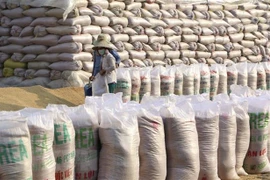Hanoi (VNA) – With quality breakthroughs in institutional reforms leading to improved growth quality and faster recovery, the average GDP growth rate would reach 6.76 percent per year in the 2021 – 2023 period, Director of the Central Institute for Economic Management (CIEM) Tran Thi Hong Minh told a workshop in Hanoi on April 22.
The event announced the findings of the report “Making economic recovery and institutional reforms intertwined after COVID-19: Way forward for Vietnam” by the CIEM with support from the Australia Supports Economic Reform in Vietnam Programme (Aus4Reform) and the Australian Embassy in Vietnam.
The document aims to identify requirements and a roadmap for Vietnam to promote economic recovery and institutional reforms in the post COVID-19 era. It focuses on key requirements to boost post-pandemic economic recovery and institutional reforms.
The pandemic is wreaking havoc on the global economy, forcing both developed and developing countries to speed up institutional reforms in combination with accessing the Fourth Industrial Revolution and the digital economy.
According to the report, Vietnam was hit by two waves of COVID-19 outbreaks in 2020. Acting swiftly at the fairly early stage of the pandemic, the country was considered relatively successful in keeping the virus at bay. All social and economic activities are on track of recovering in the first quarter of 2021.
 Director of the Central Institute for Economic Management Tran Thi Hong Minh speaks at the workshop. (Photo: VietnamPlus)
Director of the Central Institute for Economic Management Tran Thi Hong Minh speaks at the workshop. (Photo: VietnamPlus)
The country’s GDP growth rate reached 2.91 percent last year and stood at 4.48 percent in the first three months of this year. International organisations had positive assessment of Vietnam's economic growth. Albeit significantly lower than pre-pandemic level, Vietnam still outperformed most economies in the world, including those in East Asia.
Gross investment went up by 5.7 percent in 2020, 4.5 percentage points lower than that in 2019. The investment/GDP ratio reached only 34.4 percent in 2020, while the investment efficiency decreased sharply with the ICOR coefficient skyrocketing to 14.3.
The business sector, particularly in tourism, continues confronting numerous difficulties caused by direct impacts of the COVID-19.
The pandemic is projected to continue evolving complicatedly and unpredictably at the global level, that is why its serious impacts on all socio-economic aspects still linger on and cannot be fully assessed.
 CIEM hosts a workshop on April 22 to announce the report “Making economic recovery and institutional reforms intertwined after COVID-19: Way forward for Vietnam.” (Photo: VietnamPlus)
CIEM hosts a workshop on April 22 to announce the report “Making economic recovery and institutional reforms intertwined after COVID-19: Way forward for Vietnam.” (Photo: VietnamPlus)
Minh said the report elaborates on some considerations for economic recovery and economic institutional reforms in 2021-2023. These include balance of macroeconomic stabilisation and economic recovery, and the interplay between domestic economic institutional reforms and international economic integration. The role of the State and economic space for the private sector; and the timing of reform are also thoroughly analysed for economic growth recovery after the pandemic.
It also develops a corresponding policy roadmap for the 2021-2023 period, with steps to continue to effectively control the COVID-19 pandemic, alleviate difficulties for the business community and the people, in combination with implementing economic institutional reforms; implement parallel measures for economic recovery and economic institutional reforms in 2022; and phase out measures to support economic growth recovery, and focus on economic institutional reforms in 2023.
Minh noted that Vietnam’s economic prospects for the 2021-2023 period are likely to follow three scenarios. Accordingly, under the "business-as-usual" scenario with effective control of the pandemic, the GDP growth rate is projected to reach 5.98 percent in 2021 and 6.61 percent in 2023, she said.
Provided that quality breakthroughs in institutional reforms lead to improved growth quality, coupled with timely and sound fiscal and monetary policies, the average GDP growth will reach 6.76 percent per annum over the next three years, she added./.





























